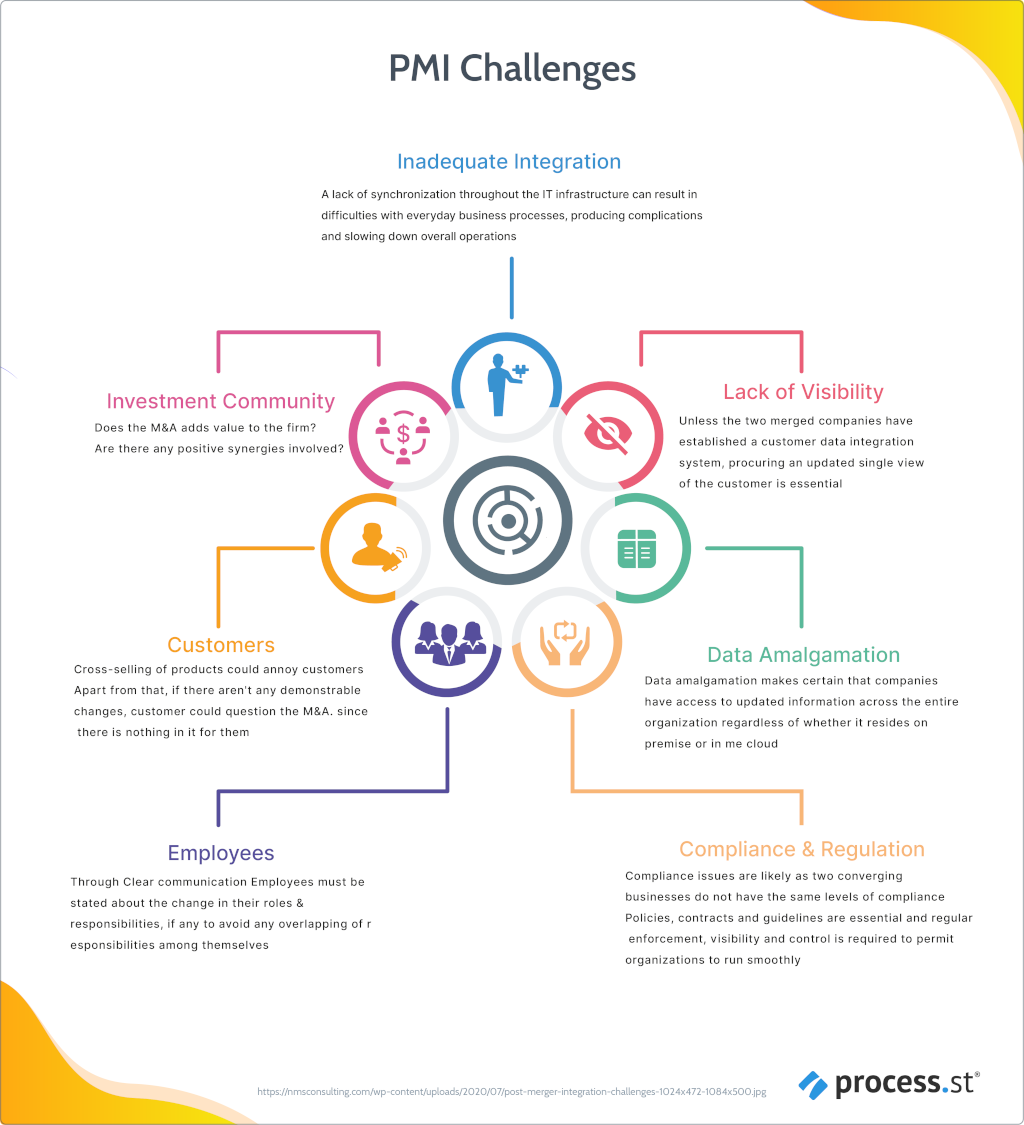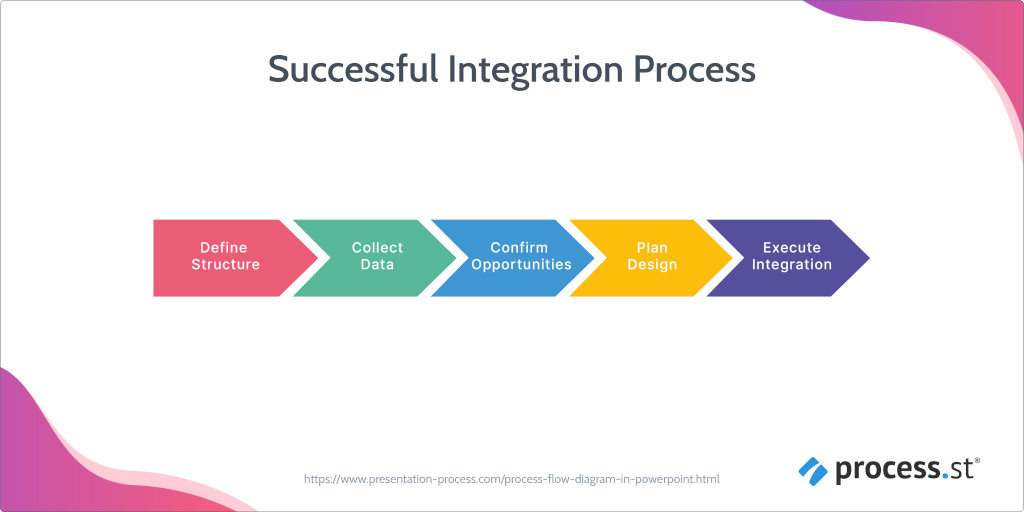
AOL and Time Warner. Daimler Chrysler. Sprint and Nextel. Quaker Oats and Snapple.
You see where this is going, right?
I admit: the role of Monday morning quarterback is not very challenging – particularly in these four cases. If nothing else, they serve as a prime reminder that even the highest flyers can – and do – fall, and fall hard.
There was a small amount of pure bad luck – the dot-com bubble burst AOL’s value, high gas prices stopped Chrysler’s SUVs in their tracks – but a large number of merger integrations fail for completely foreseeable reasons – and a good dose of human error.
In this Process Street post, I’m going to look at the three pitfalls and why they have such a huge impact on the success (or lack thereof) of your post-merger integration.
If you just came for the free template, you can grab it below:
Click here to get the Post-Merger Integration (PMI) Checklist workflow!
This workflow is designed to walk you through every stage of the post-merger integration process from pre-planning to post-mortem. While the step-by-step process will ensure nothing gets forgotten, it also provides ample space to document important decisions and data. Features like Dynamic Role Assignments, Due Dates, and Approvals keep everyone on the same page and make it immediately apparent if something is headed off course.
Unexpected obstacles will always pop up, but the PMI Process Checklist will help you prepare for the worst and make your integration run smoothly.
With that out of the way, let’s go through the most common ways it can all go wrong:
- The harsh truth of post-merger integrations
- PMI Pitfall #1: The people problem during integrations
- PMI Pitfall #2: With great change comes huge risk
- PMI Pitfall #3: How diligent is your integration due diligence?
- PMI Checklist: M&A integrations simplified
Let’s talk about some bad decisions!
The harsh truth of post-merger integrations
Most mergers fail.
The exact number varies depending on who you ask. In their article for Harvard Business Review, Professor Clayton M. Christensen, et al (Harvard), put the failure rate between 70% and 90%. Professor Robert Holthausen (The Wharton School) offers a more conservative 50% to 80%. According to Martin Sikora, one-third of mergers create shareholder value, one-third don’t meet expectations, and one-third destroy value.
“The truth is mistakes happen. The accepted data say that most mergers and acquisitions don’t work out. […] You would hope these companies have done their due diligence, although that isn’t always the case.” – Martin Sikora, professor of management and editor of Mergers & Acquisitions: The Dealmaker’s Journal
Okay. Not doing your due diligence properly will definitely come back to bite you in the ass. But two-thirds of mergers and acquisitions essentially unsuccessful? I have a humanities degree and even I know those numbers aren’t good. So what goes wrong?
In the experience of consultant Cari Windt, companies just don’t plan as thoroughly as they should.
“It’s unusual that companies work on developing quality solutions for the acceptance side of mergers.” – Cari Windt, Senior Leadership Consultant
Mergers and acquisitions – even well before the integration process – require a lot of juggling plates. As Chris Barbin points out: it’s easy to get distracted by it all. In the moment, what you think is important may not have any long-term value. When it comes to integrating, it’s tempting to give in to a small ask here and there to keep your people happy. Small asks add up into big demands on resources very quickly, though.
“The biggest cause of most failures is a lack of execution, and there is a great deal to execute on in an M&A deal. [..] Running a business and integrating two companies is like having two different jobs and both are equally important.” – Chris Barbin, CEO, Founder, Entrepreneur

If we look at the infographic above, you can see some of the broad categories that need to be managed carefully during the post-merger integration process. Each of those categories also has subcategories, which have subcategories, and so on. More to the point, without carefully planning, problems can pop up that weren’t even on your radar.
The average integration process is expected to take up to two years to complete. Even then, the two organizations may not be fully integrated. Some aspects – technology, synergies, etc. – should be verified during the due diligence process, but speed is usually a high priority during a merger.
It’s not uncommon for the ink to be well-dried on the paperwork and an executive to realize Company A’s technology is completely incompatible with Company B. A VIP customer may take their business elsewhere if they aren’t kept in the loop – or don’t see the merger as beneficial to them. Key personnel with vital expertise may choose to leave due to a lack of transparency, or loyalty to a redundant manager. That valuable piece of tech you were after may become entirely obsolete before the PMI has even finished.
As Sikora said: Mistakes happen.
Every merger is different, and every merger fails for a different reason – or so it seems. While doing my preliminary research, I noticed there were a few repeating themes in the why of an acquisition going wrong. In fact, there were three predominant reasons an integration was unsuccessful:
- Culture and/or workforce incompatibility;
- Inadequate preparation – or even awareness – of potential risks;
- Unexpected discoveries after the fact.
To me, these seemed like some of the most basic things that anyone taking on a project – let alone top executives deciding multi-billion/trillion dollar deals – should consider. So I decided to pose my questions to a few people who have first-hand experience. Bryan Sise (Marketing VP at Process Street), Blake Thorne (Product Marketing Manager), and Blake Bailey (Customer Success Content and Operations Manager) have all been involved in multiple acquisitions over the years and offered insight into the experience of acquiring, being acquired, and obstacles that pop up along the way.
PMI Pitfall #1: The people problem during integrations
“That first touch in integration is so important. It’s the ultimate first impression. And the ultimate opportunity to spoil a multi-million dollar investment is right there at the beginning.” – Blake Thorne, Product Marketing Manager, Process Street
When it comes down to it, a company is only as good as its people. Without the people – the engineers, the designers, the salespeople – you have an idea with no way to execute it on a large scale.
Yet, when it comes to post-merger integrations, people become capital that’s only relevant as it relates to the bottom line.
“Company A buying company B is really [about] buying people. You need to realize that and be aware that certain issues exist. You need to create a good impression. Good employees will quit if they feel their fellow workers are treated poorly.” – Martin Sikora
It’s to be expected that in any merger or acquisition, layoffs are very likely. Other employees may feel it’s time to move on, or decide to leave for other reasons. Sikora insisted that these issues “must be handled humanely.”
For example, the acquiring company could help the redundant employees find other jobs and ensure an acceptable and appropriate severance is offered. The acquiring company during a post-merger integration is already working at a disadvantage: employees at the acquired company are naturally going to be wary. If that isn’t managed well, it leads to fear, morale issues, and losing good employees.
“No matter what the context is, being acquired is emotional. It can be a scary experience; you don’t always know what to expect. It can feel like getting transported to an alien environment.” – Blake Thorne

For both Daimler Chrysler and Sprint/Nextel, the people problem was their biggest obstacle. Nextel’s entrepreneurial spirit clashed with Sprint’s bureaucratic traditionalism. Daimler belittled Chrysler’s products. In both instances, misinformation and miscommunication led to numerous departures of key personnel and low morale for those who stayed.
It takes more than a few months, or even years, for people who may have very different communication styles, processes, systems and priorities to feel comfortable and be productive in a new environment.” – Chris Barbin
Without those key personnel to facilitate the transition, Nextel and Chrysler employees felt marginalized and dominated. In both instances, it became a clear case of Us vs. Them, which only served to further break down communication and collaboration while widening the rather massive culture gap.
For Daimler Chrysler, the final nail in the coffin was when then-CEO Jürgen Schrempp admitted in an interview with the Financial Times in 2000 that the “merger-of-equals” he’d insisted on was a ruse.
“The structure we have now with Chrysler (as a division) was always the structure I wanted. […] We had to go a roundabout way but it had to be done for psychological reasons. If I had gone and said Chrysler would be a division, everybody on their side would have said: ‘There is no way we’ll do a deal.’” – Jürgen Schrempp, October 30, 2000
Sprint and Nextel experienced slightly less drama – no one got taken to court, anyway – but wasn’t sunshine and roses. Even their tech was incompatible (but that’s another issue). Like Daimler Chrysler, Sprint/Nextel was considered a merger of equals, despite the fact that the two companies never actually merged.
Even with separate headquarters, though, Nextel employees had to continuously seek approval from Sprint executives before taking any corrective actions. Due to a lack of trust between the two, that approval often never came.
“It’s like fusing a limb. One part has all these wriggly, exposed nerve endings; the other company has all these wriggly, exposed nerve endings. And you’re just hoping enough of them fuse together so both organisms don’t die.” – Blake Thorne
PMI Pitfall #2: With great change comes huge risk

“Even after doing all the due diligence, people often go into it with a set of rose-colored glasses. Once it gets down to the actual brass tacks – once it’s time to actually integrate the two tech stacks, the two groups of people – things can go very wrong.” – Bryan Sise, VP of Marketing, Process Street
Change and risk.
Depending on your perspective, these are either the two most exhilarating or the most terrifying words in the English language. Either way, they are the two features constant in every, single PMI process.
Considering exactly how much planning goes into developing an M&A strategy, it’s a little bit amazing that this is still an area that companies fall down on when it comes to integration.
“Integration is really about mobilizing change. The key question is, what is the change dynamic of the companies involved — how quickly do they adapt?” – Joanna Serkowski, Management Consultant
A thorough risk register and a solid risk management strategy are absolutely vital for a successful integration. Harbir Singh (Professor of Management, Wharton) believes the distinguishing feature between success and failure of an acquisition is whether the executives are able to maintain a sense of objectivity. For Singh, the primary danger to be concerned about is when executives “fall in love with the idea of the acquisition,” and want the deal to work no matter what it costs.
There are five main steps to completing the risk management process:
1. Set and align your post-merger integration objectives
This part is fairly easy. It’s already part of the pre-planning process for developing your overall M&A strategy.
This is where you clearly outline what you want to achieve, how to get there, and what KPIs you intend to use to monitor your progress. It’s important to be as specific as possible with these objectives so it’ll be clear what obstacles might get in the way.
2. Identify and document integration risks
Even if an obstacle isn’t very probable, the fact that it’s possible means it needs to be documented. Everyone thinks the worst won’t happen – until it does.
Whether a particular risk happens or not isn’t the main issue here. The point of this step is to be aware of all the things that could happen. For an integration process, there are obvious risks like the deal falls through or you aren’t able to re-recruit key personnel.
What about the risk of your project manager getting sick or movers damage your property? What if a global pandemic occurs and government functions like legal proceedings are held up for an indefinite period of time?
Things happen. Be prepared.

3. Assess documented risks
Once you’ve identified your risks, you need to determine which ones need to be prioritized. In addition to how likely something is to happen, you should also consider how they’ll impact your objectives and where they might occur during the integration process.
4. Respond to risks
In an ideal world, you would be able to avoid every possible risk simply by planning for it. That may work for some, but there will be those risks you can only hope to mitigate. You can’t make that pandemic go away, but do you have the infrastructure to keep things moving anyway?
5. Monitor risks throughout post-merger integration
And, obviously, the previous four steps are pointless if you don’t monitor your risks. Again, this will naturally fall in line with your overall strategy. You can use the same system that you use to monitor the acquisition process to keep track of any potential risks at the same time.
Change management
Now let’s talk a bit about change. Remember that people problem I mentioned earlier?

Yeah. People don’t like change. It’s scary. It brings up feelings. They may lash out or become resistant. You make your life – and your people’s lives – much easier with a change management model.
This will provide your employees with a step-by-step framework so they know exactly what, when, how, why, and who of any changes taking place. While a change management system won’t necessarily make them excited about these changes, it will give them a sense of stability and reassurance.
“In my experience, a disproportionate amount of time is spent on the financial planning, and not enough planning is spent on the technological and the human planning.” – Bryan Sise
PMI Pitfall #3: How diligent is your integration due diligence?
“Every day, the wrong companies are purchased for the wrong purpose, the wrong measures of value are applied in pricing the deals, and the wrong elements are integrated into the wrong business models.” – The New M&A Playbook
Due diligence is a central component of all M&A strategies. Naturally, you want to look over all the numbers and financials to make sure that you’re getting the best deal possible.
There are a lot more than numbers to consider.

For example: eBay.
eBay bought Skype thinking it would be a great tool for their users. Except eBay just bought the company; they didn’t buy the rights to Skype’s core technology.
There’s also the fact that video calls for an online auction site are a weird idea. I barely like video calls with my colleagues, let alone some stranger I’m buying a haunted rubber duck from.
The point is, eBay and Skype may never have been a good match, but eBay not ensuring they had full rights to use Skype’s core technology guaranteed the pair would go their separate ways.
“Companies rightly turn to acquisitions to meet goals they can’t achieve internally. But there is no magic in buying another company.” – The New M&A Playbook
PMI Checklist: M&A integrations simplified

“A solid process during an acquisition is important for two reasons: 1. A lot of stuff needs to happen and 2. It all needs to be done exactly right because the stakes are extremely high in these situations.” – Blake Bailey, Customer Success Content & Operations Manager, Process Street
Mergers and acquisitions can be very daunting. There are a lot of things to take into consideration, a lot of very important items that can’t be overlooked, and a lot of different people involved.
The integration process can be an ordeal in itself. You have tech, departments, and employees that all need to be integrated. You need to make decisions about real estate and both your own assets and those of the acquired company. You need to reassure customers, vendors, stakeholders – probably even yourself once or twice along the way.
Meanwhile, you still need to cover the day-to-day business as usual. It’s a lot. There’s a reason companies choose to outsource to expert M&A teams and advisors when they can.
Even with external help, there will be many things you need to keep track of yourself – including those external advisors. This Post-Merger Integration Process Checklist will walk you through each stage of a basic PMI process while also documenting important information like contact details for key roles, success metrics for integration, and meeting records.
Click here to get the Post-Merger Integration (PMI) Checklist workflow!
With approvals, you’ll be able to keep track of every decision that’s made throughout the integration process. Task assignments and stop tasks will make sure the right people are completing the right tasks in the right order.
Plus, you can check the status of every workflow run from your dashboard.
“Whether you’re doing it for 10 employees or 10,000, the experience is exactly the same for you. It’s the same level of effort, and the employee has a seamless experience. You can also see exactly where everyone is in terms of progress. Who’s lagging behind, who’s doing really well, etc. Being able to track those things for reporting is super important.” – Blake Bailey
Will this be happily ever after?

“Bringing two companies together is not unlike a marriage. Sometimes opposites attract and complement each other, but for a marriage to work, you really need to share the same values. While few companies will ever share a complete culture match, if the values are aligned, it can work.” – Chris Barbin
Mergers are complicated. The stakes are high, the fine print extensive, and one wrong decision can bring the whole thing crashing down.
And that’s before you’ve reached the post-merger integration (PMI) stage.
The analogy of a marriage is apt. Even the most level-headed managers with the most thorough strategy may find themselves hyperfocused on one area while overlooking another and being overly optimistic about the future.
It’s an exciting, stressful, and intense time. But, like a marriage, there’s a lot of work to do before the Big Day, and even more to do after – especially if you want the kids to get along.
Have you been through a post-merger integration? Was it a successful marriage, or did it end with someone’s belongings on the lawn?







Leks Drakos
Leks Drakos, Ph.D. is a rogue academic with a PhD from the University of Kent (Paris and Canterbury). Research interests include HR, DEIA, contemporary culture, post-apocalyptica, and monster studies. Twitter: @leksikality [he/him]